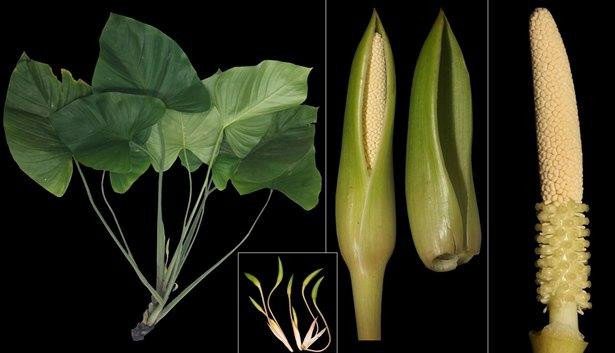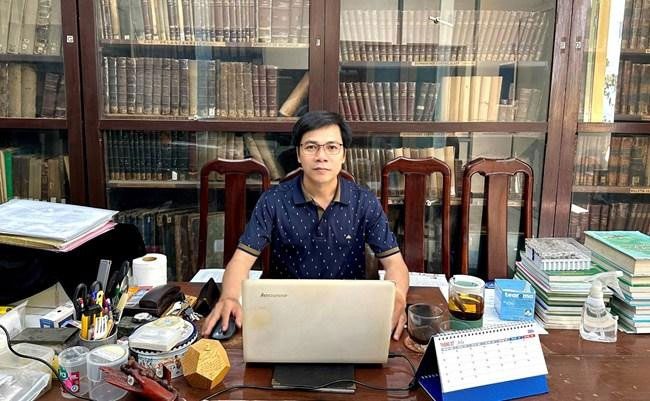Hundreds of medicinal plant species on major islands near the coast of the Southern region of Vietnam have been discovered by Associate Professor Dr. Dang Van Son and his team, who have isolated valuable compounds to inhibit cancer cells in humans.
A Series of Rare Plants Discovered
Associate Professor Dr. Dang Van Son and his colleagues from the Tropical Biology Institute – Vietnam Academy of Science and Technology have successfully developed a database on medicinal plant resources on major islands near the Southern coast.

Côn Đảo’s Homalomena perplexa is a newly described medicinal plant.
The data is managed and utilized through specialized software compatible with the global data system GBIF. The research results play a crucial role in the management, conservation, and sustainable use of medicinal plant resources in the area.
According to Associate Professor Dr. Dang Van Son, in Vietnam, the naturally growing medicinal plants provide 10,000 – 20,000 tons annually, meeting domestic demand. Many medicinal plants with high economic value are regularly exported.
However, due to various reasons such as climate change, natural disasters, and unsustainable exploitation, the medicinal plant resources in Vietnam are facing severe decline. Statistics show that 144 species are listed for conservation in Vietnam.
The Southern region is the southernmost part of Vietnam, and there has not yet been an in-depth research project on the potential and current status of medicinal plant resources in this area. Scientists have conducted surveys on six major islands near the coast, including: Phu Quoc, Con Dao, Nam Du, Hon Son, Hon Tre, and Long Son.
The surveys recorded 1,113 species belonging to 620 genera and 166 families across four classes of vascular plants, including Lycopodiophyta, Polypodiophyta, Pinophyta, and Magnoliophyta. Among them, 99 medicinal plant species are of conservation value according to the Vietnam Red Book.
The research team has successfully built a digital database for 300 sample codes of 117 medicinal plant species on major islands near the Southern coast using the BRAHMS software. The team also collected 351 specimen samples, which are stored at the Museum of Animals and Plants (under the Tropical Biology Institute).
Additionally, Associate Professor Dr. Dang Van Son and his colleagues have isolated and identified the structure of four compounds from Macrosolen tricolor, a potential medicinal plant species. The biological activity of this extract shows that it has inhibitory, anti-inflammatory, and cytotoxic effects on breast cancer cells.
Notably, among the recorded medicinal plant species, one new species has been described and published scientifically, named Homalomena perplexa K.Z.Hein, Vuong, Bao & V.S.Dang. This species was discovered in Con Dao National Park, Ba Ria – Vung Tau Province, and was published in the international journal Taiwania.

Associate Professor Dr. Dang Van Son.
Considering the Propagation of Valuable Medicinal Plants
Associate Professor Dr. Dang Van Son shared that the medicinal plant resources on major islands near the Southern coast are quite diverse and abundant. Many species are easy to cultivate, well-adapted to coastal climatic conditions, and have high economic value, such as Con Dao ginseng, agarwood, blood dragon, southern crow’s beak, rose myrtle, Homalomena perplexa, Macrosolen tricolor, and others. This group of medicinal plants needs further research on cultivation models and should soon expand propagation locally to improve the income of coastal residents.
Among these, many species are also a source for extracting and refining active compounds used in biological preparations such as capsules, tablets, instant teas, syrups, etc. These products are often easy to use, highly effective, and cost-effective.
The research results also recorded 20 folk remedies from local people using either single or multiple medicinal plant species. However, many islands, especially those far from the coast, have yet to be surveyed.
“The team aims to continue expanding research to create a more complete and comprehensive database in the future on rare medicinal plant species on the islands near the Southern coast. Successful research plays a significant role in creating livelihoods for coastal residents while developing safe health care products.
Once the species and active compounds are identified, propagation for widespread planting in the area is not difficult. These are species containing valuable compounds, hence their great development potential,” Associate Professor Dr. Dang Van Son noted.
Associate Professor Dr. Dang Van Son is the author and co-author of 200 scientific papers, over 100 of which are published in international journals listed in the SCI/SCIE database, and he is also the author and co-author of three specialized monographs on botany.


















































